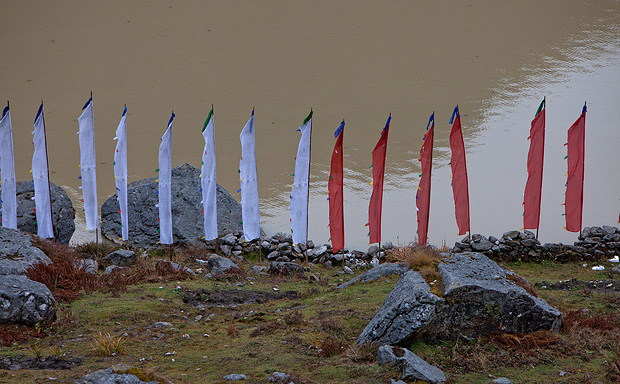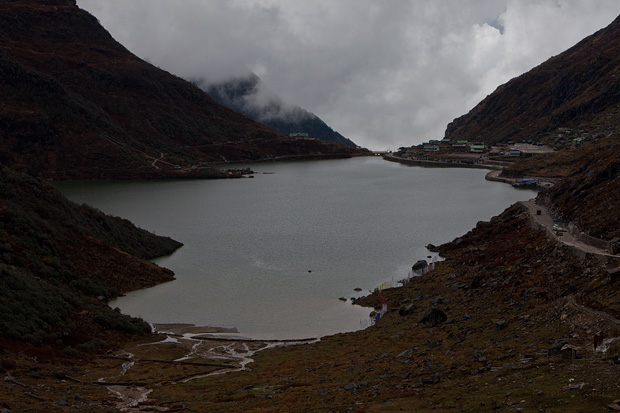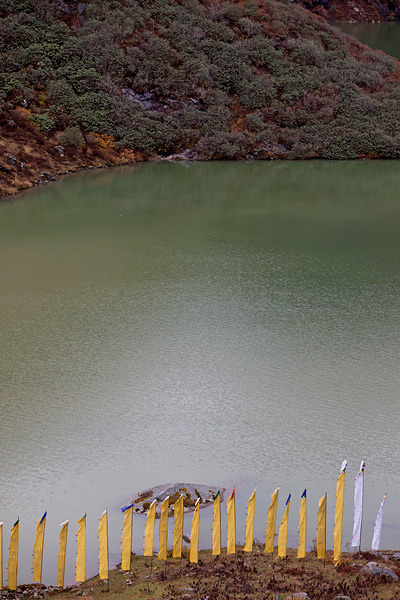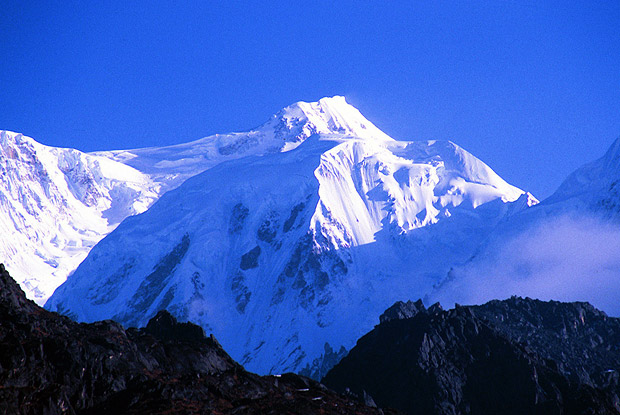Changu Lake was one of the places that I was eager to see during my recent trip to Sikkim. But when I got there, somehow I wasn’t charmed by it as I hoped for. It could be all the touristy construction and army bunkers around it or it could just be me. Indian Army has a considerable presence near Changu Lake, thanks to our friendly neighbours across the border who love our land so much that they get possessive about it.
My attempt to get good pictures of the lake failed miserably, but I did not give up completely on it. It did not help that I spent very little time next to the lake. What did help a bit is a magic formula that the mountain people in the Himalayas use for making anything and everything pretty. The fluttering prayer flags along the shore brought alive the lake that otherwise lacked luster.
A few pictures here, they definitely could’ve been better.



About Changu Lake
Changu Lake is located on the Gangtok-Nathula road at an altitude of 12,400 feet. Although it is only 40km from Gangtok, the mountain roads ensure that it is a whole day’s trip to visit the lake and get back to the town. Visit to the lake requires an inner line permit, which has to be obtained at Gangtok at least a day earlier. Most people normally combine the visit to Changu with Nathula, about 10km ahead on the same road.
There are basic tourist facilities next to the lake, where you can savour some momos and shop for souvenirs from Sikkim.
A trip report of a journey to lakes of and rivers of North Sikkim, made in October 2003. Some images here are taken from a previous trip to Sikkim
Also see: Trek report to Gochela, Sikkim
We arrived in Gangtok after a long and tiring journey of six hours in a dilapidated and crowded jeep. Gangtok is accessible only by road and the steep slopes and curves on the road make your journey much harder. But when we reached the town, we knew we were going to have a good time in the next few days.
A TOWN WITH A DIFFERENCE
It’s hard to find a place flat and big enough to play soccer in Gangtok. The town is built on a series of hills in the Eastern Himalayan state of Sikkim. When you are walking from place to place, you are always climbing up or down which tires you very quickly. We spent the first day in exploring the town and making preparation for further journey. The first thing that we could see when we woke up next morning was a magnificent view of Kanchenjunga, the highest peak in India. It was visible from any point in town as if to prove its might

Kanchenjunga seen from Gangtok
We strolled around leisurely all the day. The hills just above the town have many beautiful waterfalls. Ganesh Tok, the highest point in the town offers good view of the valley below and a range of distant snow clad mountains if you reach there early in the day.

Orchids
We also saw a few orchid gardens that showcase the flowers that grow in the region. Near Ganesh Tok is a Buddhist monastery but it was closed for visitors when we went there. But we found a restaurant nearby which was selling a local delicacy called momo – steamed flour stuffed with vegetables or chicken. A good serving of momos and hot tea made us forget about the closed monastery.

A Waterfall near Gangtok
HEADNING NORTHWARDS
Next day we headed north of Gangtok to explore the alpine lakes and rivers of Sikkim. Our jeep driver was a friendly man and warmed up to us quickly after the initial hesitation. Both the driver and our guide proved to be a funny people who kept us laughing and chatting all through the journey.
The road keeps ascending higher and higher and was getting narrower and steep as we continued through the journey. Condition of roads remained bad due to continuous landslides that prevented any road work. There was no tarmac in parts of the road and sometimes the jeep had to wade through streams that ran right through the road. As we moved further, the hills seemed to get taller and the valleys deeper.

A Stream on the way
We stopped at a few waterfalls and walked around the streams, but all the time our driver kept asking us to hurry since we had to reach before nightfall. Driving in the night would have been unsafe on these roads and he wanted to reach our destination before sunset. Sometime late in the afternoon we spotted the snow capped Himalayan mountains at a distance. We were headed towards them and were going to be in the middle of them by tomorrow. We reached Thangu village around 8pm where people at a guesthouse were expecting us. At the end of a long day’s journey we had climbed 9000 feet – from 5000 feet at Gangtok to 14000 feet at Thangu.

A Stream at Thangu village
A FUN FILLED EVENING
It was cold at Thangu and we could see snow on the top of a few nearby mountains. But the fireplace at the guesthouse kept us warm. We spent the whole evening with the family who run the guesthouse.
They were really nice people and offered us some local millet wine called Chhang. The evening was spent chatting with them, with some friendly conversation and getting to know their way of life in the mountains. Despite all the hardships of the weather, their smiles and enthusiasm never seems to fade. The evening gathered more color when we all sat together at the fire place and started singing, taking turns. A couple of other guests joined in and we had a great time together. We retired for the day after guzzling plenty of Chhang and food for our hungry stomachs.
THE GURUDONGMAR LAKE
Next morning we headed towards the Gurudongmar Lake – one of the highest alpine lakes in the world located at a height more than 17000 feet. The initial part of the journey took us through narrow road with no tarmac and a stream flowing just besides us. We hit a plateau after driving for sometime where the road disappeared altogether and we were driving as we pleased on the plane land. The jeep was a tough vehicle and took us through it with little difficulty. We reached the lake at around 11am.

Rhododendrons
It’s a vast lake bound by snowy mountains on one side and a few hillocks on the other. The water is crystal clear and absolutely still making a great sight with the reflection of the mountains behind it. The lake is created by Tista glacier running down from on of the mountains ahead. A small stream emerges from the overflowing lake that eventually joins Tista River downstream. Prayer flags tied by the Buddhist visitors surround the lake, and there is small temple by the shore.
The quick ascent to the high altitude had left us in discomfort very soon. We retreated from the lake in an hour’s time and headed back to the village and further down. After driving the entire afternoon, we reached the town of Lachung where we checked in for the night.
YUMTHANG VALLEY
Our next destination was Yumthang Valley where river Yumthang flows down in the middle of flowering rhododendrons and alpine trees. The road to Yumthang is full of Rhododendron trees and they fill the whole area with colors when in bloom. Yumthang valley offers a wide vista where the valley floor is littered with purple flowers in season, with the river flowing in the middle of them. We spent a few hours in the valley and headed up further where we saw a local tribal with a herd of Yaks. Milk and butter from the yaks are a primary source of income in these parts.

A Yak grazing
As we descended, we headed for a hot spring just below the Yumthang valley. We dipped into the hot water and stayed there for nearly an hour. A heated pool in that cold climate is the ultimate luxury that you can ask for. We headed back to Lachung after feeling refreshed in the pool followed by a short walk by the river.
RETURN TO GANGTOK
We returned to Gangtok the very next day. We stopped on the way back by the tall Lachung waterfall which falls from a good height just besides the road. We spent another day back in Gangtok to visit a Zoological Garden with wide variety of animals including the rare and endemic Red Pandas and the Himalayan Sloth Bears. After some shopping for souvenirs as a reminder of the memorable visit, we descended back to the plains and back home, contented about having made a good trip.

Leopard at Gangtok Zoo
ADDITIONAL INFORMATION
Nearest airport o Gangotok is Bagdogra, which is 6 hours away. Bagdogra is a small airport connected from Delhi and Kolkata. Mos
t people fly to Kolkata which is well connected by rest of the country and then take a bus or train from Kolkata to Siliguri(600kms). Gangtok is 6 hours from Siliguri town.
Gangtok offers plenty of places to stay in all budget ranges but people usually use this town as a stop over for heading further as we did. We stayed at a small unnamed hotel which offered us clean rooms and hot water at Rs.500 a day. Check MG Road in the heart of the town for some good accommodation.
You need to hire guides and a jeep at Gangtok to travel further to Gurudongmar and Yumthang valley. Keep in mind that access to parts of North Sikkim requires permits and this can be arranged only through an authorized travel agent. A travel agent may charge upto Rs. 2500 a day for a jeep and guide. Most of the travel agents are at MG Road and whom you hire may not make much difference.
Best time to visit: May and June











